Dealing with Seasonal Affective Disorder (SAD)

What is Seasonal Affective Disorder (SAD)?
Seasonal Affective Disorder (SAD), commonly known as seasonal depression, is a significant mental health issue that affects millions worldwide each year. Contrary to popular belief, SAD is not just a form of “winter blues” but a serious condition lasting about 40% of the year for those affected. According to the American Psychiatric Association, around 5% of Americans experience SAD, facing a challenging shift in mood and outlook that can be hard to mitigate.
“The idea that depression could fade in and out according to the weather just rings as another ‘excuse’ that people with depression are accused of making. And, unfortunately, people living in the middle of untreated SAD are often simply unable to deal with the accusations and ignorance that comes from the lack of proper education.”
Excerpt from “The Guardian” by Susana Adame
How to Treat Seasonal Affective Disorder
Many people with SAD prefer to hide their condition, often pretending everything is fine while struggling internally. However, there are effective ways to manage and treat SAD.
Cognitive Behavioral Therapy (CBT)
Seasonally timed antidepressants, cognitive behavioral therapy (CBT), and counseling have proven beneficial.
Light Box Therapy
Home treatments, such as light box therapy, can also help. Light boxes emit light similar to sunlight, alleviating symptoms during months with limited daylight. Columbia University’s Irving Medical Center cautions against low-priced, untested light therapy devices, emphasizing the need for safe and effective options.
Dim-Light Simulators
Another treatment option is the use of dim-light simulators, which recreate the ambiance of a summer morning and provide a positive start to the day. These devices can significantly improve the mood of those with SAD.\
Get in Touch with Intent Clinical Today to Help Treat SAD Disorder
For those supporting a loved one with SAD, the best approach is to offer a safe, open space for communication and support while allowing them room to breathe. Overwhelming someone with help can be counterproductive but letting them know you are there can be a lifeline. Supporting someone through their difficult months can be challenging, but crucial for their journey towards recovery.

